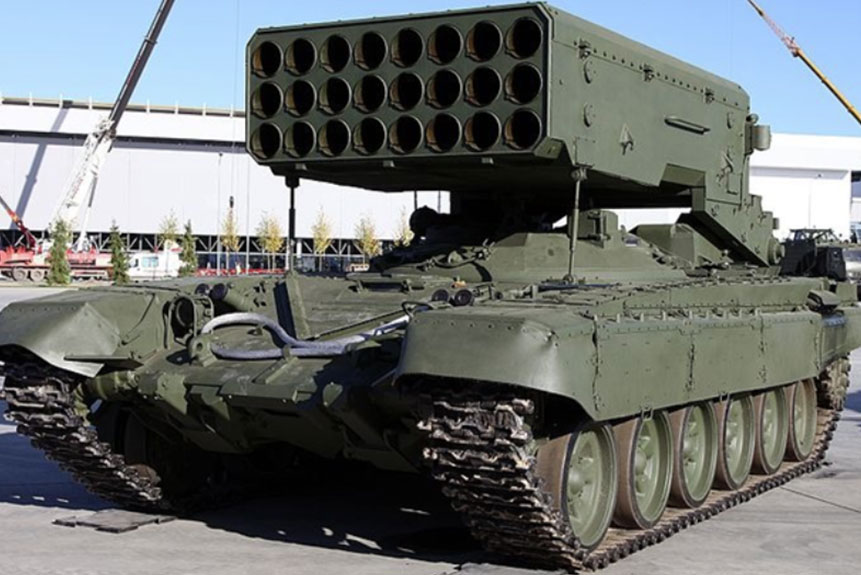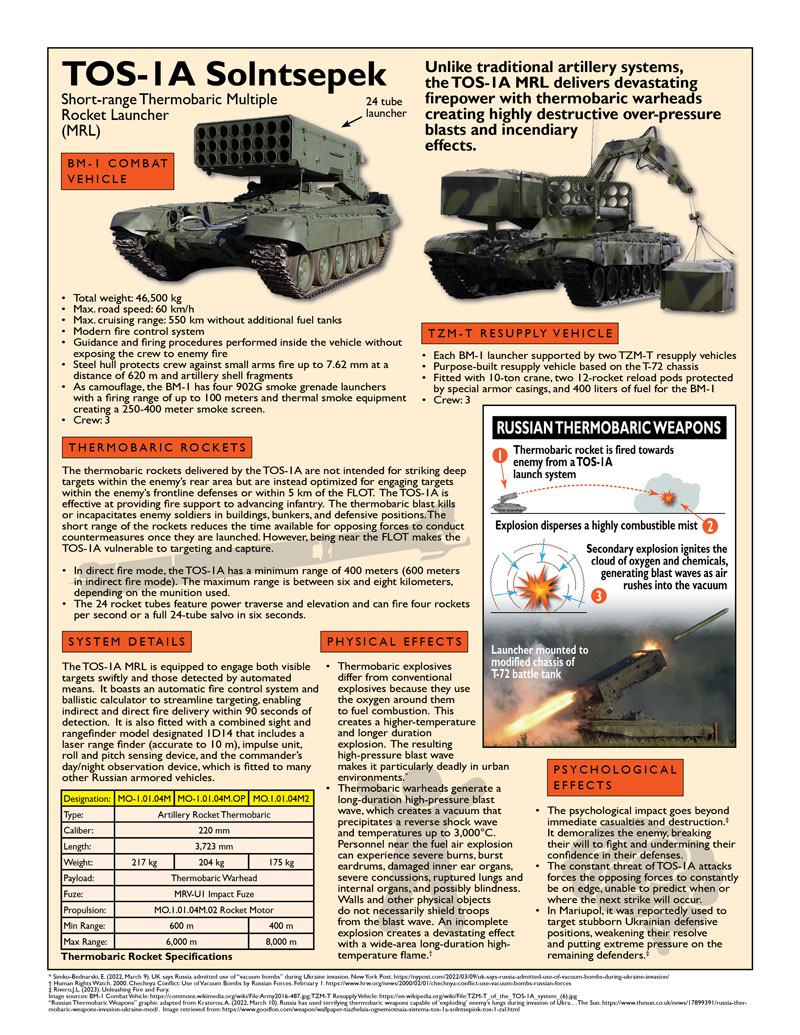
Russia’s Thermobaric Weapons Employment in the Ukrainian Conflict
Richard L. Garcia & Colin Colley
The TOS-1A Solntsepek multiple rocket launcher, a potent short-range thermobaric weapon system, has been the subject of significant interest since the outset of the conflict in Ukraine. The TOS-1A is doctrinally assigned to the Russian Army’s nuclear, biological, and chemical protection troops at the military district and combined arms army level.
The TOS-1A Solntsepek multiple rocket launcher (MRL), a potent short-range thermobaric weapon system, has been the subject of significant interest since the outset of the conflict in Ukraine. Its deployment was first documented in February 2022, coinciding with Russia’s invasion of Ukraine. Cameras positioned along the Belarus-Ukraine border captured images of the TOS-1A entering Ukrainian territory.
The TOS-1A is a short-range firepower platform doctrinally assigned to the Russian Army’s nuclear, biological, and chemical protection troops at the military district and combined arms army level. Although not designated as divisional or regimental assets, TOS-1As are often attached to Russian maneuver brigades tasked with operations against fixed defensive positions, particularly in urban environments or mountain terrain. Fi While Russia had employed it sparingly in conflicts such as Chechnya and Syria, its employment in Ukraine has been confirmed through multiple sources.
Russia has employed the TOS-1A in various stages of the conflict in Ukraine, where its design as a thermobaric MRL enables it to deliver both firepower and incendiary effects, which physically destroy infrastructure and undermine enemy morale. This has proved particularly effective in overcoming Ukrainian forces defending key terrain, especially in urban areas. Footage shared on social media of the employment of the TOS-1A vividly captures the moment missiles contact the ground, resulting in towering flames and widespread damage.ii In eastern Ukraine, where the cities of Donetsk and Luhansk have continued to see heavy fighting, Russian forces have used the TOS-1A to target and destroy enemy positions and fortifications.
However, the TOS-1A has had little to no effect on the outcome of the war in Ukraine despite its formidable capabilities. Only a portion of Russia’s estimated prewar inventory of 48 TOS-1A systems have been engaged in the conflict. Of those, Ukrainian forces have reportedly managed to damage, capture, or destroy approximately 15 systems, significantly reducing their operational effectiveness.
Ukraine’s success in countering the TOS-1A thermobaric system is due to various countermeasures and defensive strategies, including improved defensive positions, implementation of early warning systems, and advanced radar and missile defense systems. Additionally, Ukraine has leveraged advanced anti-armor capabilities and tactical adaptations to minimize exposure and vulnerability to the TOS-1A.iii The TOS-1A’s limited range means it must be positioned close to the forward line of troops, making it vulnerable to targeting and capture by enemy forces. Another system limitation is the weapon cannot be launched in the rain or at high altitudes because the rockets use an oxidizer premix.iv Reporting has indicated that Ukrainian forces have also used at least one captured TOS-1A system in a June 2023 counteroffensive to overwhelm Russian defensive positions near Kreminna in the Luhansk region.
Russia has modified the TOS-1A employment method based on Ukrainian targeting focus. To help avoid detection, Russian forces move one system at a time to the front, reducing the likelihood of detection.v Russian artillery is used to cover the TOS-1A’s movement as the system moves close to the forward line of troops before firing.vi The TOS-1A is frequently used to breach obstacles in support of advancing infantry. In the defense, the TOS-1A engages enemy troops in the open and is a powerful tool when executing final protective fires at close range.vii
Understanding the TOS-1A’s capabilities and operational dynamics is crucial for assessing its role in contemporary conflict scenarios and provides valuable insights for the U.S. Army’s training community. Although thermobaric weapons are not new to the battlefield, ground-based, rocket-delivered thermobaric systems are a relatively recent development. Their effective capabilities against infrastructure and fortified positions are well documented, and further enhancements in thermobaric weaponry are likely. Replicating a system such as the TOS-1A into realistic training events will require significant planning. Training would benefit from an emphasis on effectively identifying, targeting, and countering thermobaric munitions and fully developing the signatures of the systems used to deliver these munitions. Medical services should be prepared to treat the severe injuries caused by a thermobaric blast.
(Click here to view full image)
Figure 2: Infographic design by Keith French
Distribution A: Approved for public release
Categories:
Tags:
Russia’s Thermobaric Weapons Employment in the Ukrainian Conflict
Richard L. Garcia & Colin Colley
File Size:
212.04KB
File Type:
Page Count:
2


